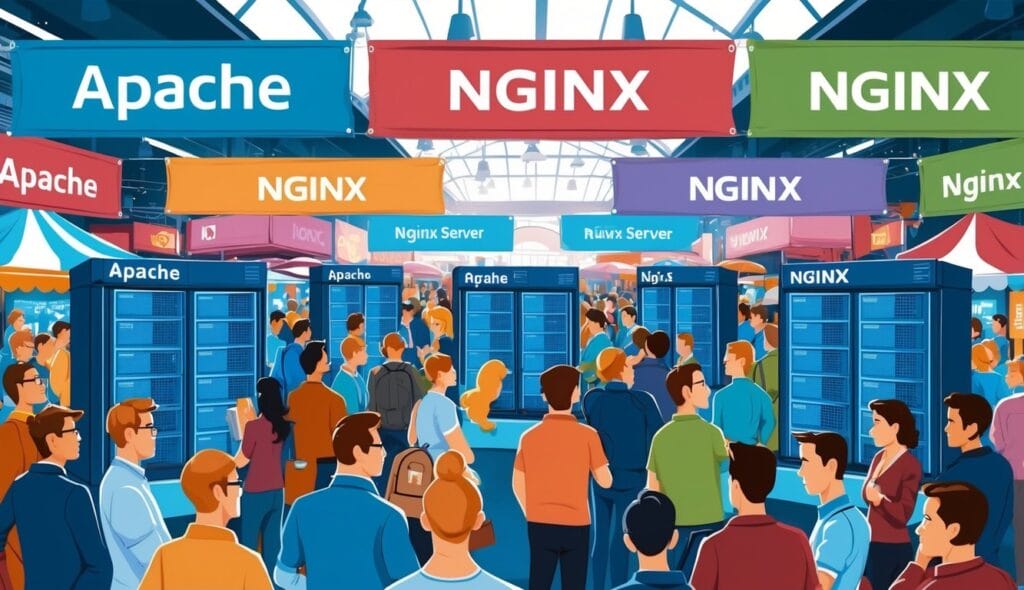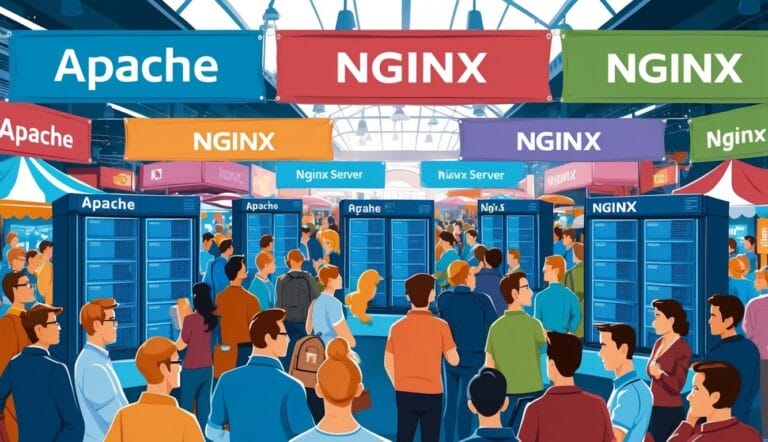Web servers are crucial for hosting websites and applications. Two of the most popular options are Apache and Nginx. These powerhouse servers handle a large portion of internet traffic worldwide.

Table of Contents
Apache has been around longer and is known for its flexibility. It can handle many types of websites and offers lots of customization options. Nginx came later but quickly gained popularity for its speed and efficiency. Nginx can handle more connections at once, making it great for busy websites.
Both servers have their strengths. Apache works well with many different programming languages and has a huge collection of add-ons. Nginx shines in serving static content and as a reverse proxy server. The choice between them depends on your specific needs and the type of website you’re running.
Key Takeaways
- Apache offers more flexibility while Nginx provides better performance for high-traffic sites
- Nginx excels at serving static content and can handle more concurrent connections
- Both servers are widely used and support various web technologies and programming languages
Historical Context and Popularity

Apache and Nginx are two major players in the web server space. Their origins and market presence have shaped the internet landscape over the years.
Origin of Apache and Nginx
The Apache HTTP Server started in 1995 as a project to improve the NCSA HTTPd server. A group of developers formed the Apache Software Foundation to support the project. Apache quickly became popular due to its flexibility and robust features.
Nginx came later, in 2004. Igor Sysoev created it to solve the C10k problem – handling 10,000 concurrent connections. Nginx was designed to be lightweight and efficient, focusing on high performance and low resource usage.
Both servers are open-source, but their design philosophies differ. Apache aims for flexibility, while Nginx prioritizes speed and efficiency.
Market Share and Trends
The web server market has seen shifts over time. Apache dominated for many years, but Nginx has gained ground.
In 2020, Apache led with a 36.2% market share, compared to Nginx’s 32.4%. By 2023, this gap narrowed significantly.
Nginx’s growth is linked to its performance with static content. It can handle over 2 million requests per second, outpacing Apache in some benchmarks.
Many large websites and tech companies now use Nginx. Its efficiency in handling concurrent connections makes it popular for high-traffic sites.
Architectural Differences
Apache and Nginx have distinct approaches to handling web traffic. These differences affect their performance and resource usage.
Process Management Models
Apache uses Multi-Processing Modules (MPMs) to manage requests. It offers three main MPMs: prefork, worker, and event.
The prefork MPM creates a new process for each connection. This model is simple but uses more memory.
Worker MPM uses threads instead of processes. It’s more efficient than prefork for handling many connections.
Event MPM improves on worker by handling keep-alive connections more efficiently. It uses fewer resources for idle connections.
Nginx uses an event-driven architecture. It relies on asynchronous, non-blocking event handling. This allows Nginx to manage many connections with fewer resources.
Handling Client Requests
Apache processes requests in a linear fashion. Each connection ties up a worker until it’s complete.
Nginx uses worker processes to handle multiple connections. These workers can manage thousands of concurrent connections efficiently.
Nginx’s event-driven model allows it to scale better under high loads. It can handle more concurrent connections with less memory use.
Apache’s process-based approach can be easier to configure for complex setups. But it may struggle with very high traffic loads.
Both servers can use modules to extend their functionality. Apache’s modules are more tightly integrated, while Nginx modules are typically compiled in.
Performance and Resource Management
Apache and Nginx handle server tasks differently. This affects how fast they work and how much computer power they use. Let’s look at how they deal with content and caching.
Serving Static and Dynamic Content
Nginx is very good at serving static content. It can handle many requests at once without slowing down. This makes it great for busy websites. Nginx uses less computer memory than Apache for the same tasks.
Apache is better with dynamic content. It can run scripts inside web pages without extra software. Nginx needs help from other programs to do this.
For big websites with lots of visitors, Nginx often works faster. It can handle the C10K problem, which means dealing with 10,000 connections at the same time.
Caching Capabilities
Both servers use caching to speed things up. Caching saves website parts so they load faster next time.
Nginx has a built-in cache manager. It can store both static and dynamic content. This helps websites run faster with less work from the server.
Apache also has caching tools. It can cache dynamic content well. But Nginx is often seen as better at caching overall.
For high-traffic sites, Nginx’s caching can really help. It keeps the server running smoothly even when lots of people visit at once.
Configuration and Flexibility
Apache and Nginx differ in how they handle configuration and allow for customization. These differences impact setup complexity and adaptability to various use cases.
Configuration Files and Directives
Apache uses a main configuration file called apache2.conf or httpd.conf. It also allows .htaccess files for per-directory settings. This setup gives users more control over specific directories without needing server-wide access.
Nginx uses a centralized configuration approach. Its main config file is nginx.conf. Instead of .htaccess, Nginx uses server blocks and location blocks to define settings for different sites and URL paths.
Apache’s directives are more numerous and detailed. Nginx aims for simplicity with fewer, more focused directives.
Modules and Extensibility
Apache has a modular architecture. It supports static and dynamically loaded modules. This allows users to add or remove features without recompiling the server.
Nginx also uses modules but requires recompilation to add new ones. This can make it less flexible for some users.
Both servers offer a wide range of modules. These cover functions like URL rewriting, SSL/TLS support, and content compression.
Apache’s module system is more extensive. It allows for deeper customization of server behavior.
Security and Encryption
Apache and Nginx offer robust security features and encryption capabilities. Both web servers provide options to protect websites and data from threats.
Integrated Security Features
Apache includes security modules like mod_security for web application firewall functionality. This helps prevent attacks like SQL injection and cross-site scripting. Apache also supports IP-based access control and user authentication.
Nginx has built-in rate limiting and connection limiting features. These help prevent DDoS attacks by controlling the number of connections from a single IP address. Nginx also offers access control and basic authentication.
Both servers can be configured to hide server information from potential attackers. This makes it harder for hackers to exploit known vulnerabilities.
SSL/TLS Configuration
Apache and Nginx support SSL/TLS encryption to secure data in transit. They both allow HTTPS implementation to protect sensitive information like passwords and credit card details.
Apache uses mod_ssl module for SSL/TLS support. It offers flexible configuration options for different SSL protocols and ciphers.
Nginx has integrated SSL termination capabilities. This allows it to handle SSL traffic efficiently without additional modules.
Both servers support the latest TLS protocols and can be configured to use strong ciphers. They also allow certificate management and can be set up with Let’s Encrypt for free SSL certificates.
Compatibility and Support
Apache and Nginx differ in their compatibility with various operating systems and platforms. They also have distinct communities and documentation resources that impact their overall support ecosystems.
Operating Systems and Platforms
Apache runs on a wide range of operating systems. It supports Unix, Windows, and FreeBSD. This makes Apache a versatile choice for many environments.
Nginx also works on multiple platforms. It shines on Unix-based systems but has limited Windows support. Nginx excels in cloud hosting setups due to its efficient resource usage.
Both servers handle PHP well. Apache uses mod_php, while Nginx typically pairs with PHP-FPM. This affects performance and setup complexity.
For WordPress sites, both servers work well. Apache often requires less configuration, while Nginx may offer better performance for high-traffic sites.
Community and Documentation
Apache has a large, established community. Its extensive documentation covers many topics. This wealth of information helps users solve problems quickly.
The Apache Software Foundation provides official support. Many third-party resources also exist due to Apache’s long history.
Nginx has a growing community. Its documentation is comprehensive but may be less extensive than Apache’s. The company behind Nginx offers commercial support options.
Both projects are open-source. This allows users to contribute improvements and fixes. It also means frequent updates and security patches for both servers.
Advanced Features and Use Cases
Reverse Proxy and Load Balancing
Nginx excels as a reverse proxy server, directing client requests to the appropriate backend servers. It efficiently distributes incoming traffic across multiple servers, ensuring balanced loads and improved response times.
Key features include:
- URL rewrites for clean and SEO-friendly links
- Efficient handling of WebSocket connections
- Ability to cache content, reducing backend server load
Apache also supports reverse proxy functionality, but Nginx’s event-driven architecture makes it more efficient for this task. Nginx can handle a large number of concurrent connections with less resource consumption.
Handling High Traffic Scenarios
Both web servers offer tools for managing high traffic, but their approaches differ. Nginx’s design allows it to handle many users simultaneously without excessive memory or CPU usage.
Nginx provides:
- Advanced connection handling capabilities
- Built-in load balancing features
- Easy configuration for performance tuning
Apache relies on its multi-processing modules to manage concurrent connections. While effective, this method can be more resource-intensive under extreme loads.
For websites expecting sudden traffic spikes, Nginx’s ability to maintain performance under pressure makes it a popular choice. Its lightweight nature and efficient resource use contribute to better scalability in high-traffic environments.
Adoption and Integration
Apache and Nginx have different approaches to adoption and integration with other systems. These differences affect how they work with content delivery networks and web applications.
Content Delivery Networks
Nginx performs well with static content, making it a top choice for content delivery networks (CDNs). Its ability to handle many connections at once helps CDNs serve files quickly to users around the world.
Nginx’s design allows it to work smoothly with CDN setups. It can cache content and distribute it efficiently across multiple servers. This makes websites load faster for users in different locations.
Apache can also work with CDNs, but it may need extra setup. Its module-based structure lets it add CDN features, but this can be more complex than Nginx’s built-in capabilities.
Integration with Web Applications
Apache has been around longer and works well in shared hosting environments. It can handle dynamic content directly, which makes it easy to use with many web applications. Apache’s .htaccess files allow for directory-level settings, giving more control to app developers.
Nginx needs extra software to process dynamic content. But it can act as a reverse proxy, sending requests to other servers that run web apps. This setup can improve performance and security.
Both servers can integrate with popular web applications. Apache might be easier for beginners due to its wide support. Nginx often needs more setup but can offer better performance for high-traffic sites.
Logging and Monitoring
Apache and Nginx both offer robust logging capabilities. They use similar formats for their access logs by default.
Apache’s access logs typically follow the NCSA Common Log Format. Nginx also uses this format for its access logs.
Both web servers allow customization of log formats. Admins can add or remove fields to suit their needs.
Apache and Nginx access logging are quite similar. This makes switching between servers easier for monitoring purposes.
Error logs in both servers capture issues and debugging information. These logs help troubleshoot problems quickly.
Apache’s server configuration for logging is done in the httpd.conf file. Nginx uses the nginx.conf file for similar settings.
Nginx’s location blocks can be used to set specific logging rules for different URL paths. This allows for more granular control over logging.
Both servers support log rotation to manage file sizes and maintain historical data. This helps prevent logs from consuming too much disk space.
Third-party tools can be used with both Apache and Nginx to enhance monitoring capabilities. These tools can provide real-time analysis and alerts.
Frequently Asked Questions
Apache and NGINX have key differences in performance, PHP handling, security, configuration, and resource usage. These factors impact which web server may be better suited for different use cases and requirements.
What are the performance differences between Apache and NGINX?
NGINX often outperforms Apache in handling static content and concurrent connections. It uses an event-driven architecture that allows it to handle many requests with less memory and CPU usage.
Apache uses a process-based model, which can be less efficient for high-traffic sites. But it excels in processing dynamic content through embedded interpreters.
How do Apache and NGINX differ in handling PHP requests?
Apache can process PHP requests directly using mod_php. This method is simple to set up but can use more resources.
NGINX requires an external PHP processor like PHP-FPM. This separation can improve performance and security, but it needs more configuration.
What are the security implications of choosing Apache vs NGINX?
Both Apache and NGINX are secure when properly configured. NGINX’s smaller codebase may present a smaller attack surface.
Apache offers fine-grained access control through .htaccess files. NGINX doesn’t support .htaccess, which some consider a security benefit as it prevents potential misconfigurations.
How does the configuration of virtual hosts differ in Apache and NGINX?
Apache uses a directory-based approach for virtual hosts. Each site typically has its own configuration file in the sites-available directory.
NGINX uses a server block system for virtual hosts. This approach can be more centralized and easier to manage for multiple sites.
Which web server is considered lighter in terms of resource usage, NGINX or Apache?
NGINX is generally considered lighter in resource usage. Its event-driven architecture allows it to handle more connections with less memory and CPU.
Apache can be more resource-intensive, especially under high loads. But it offers more flexibility in processing methods, which can be beneficial for certain setups.
Can you compare the benchmark results between NGINX and Apache?
Benchmark results often show NGINX performing better in serving static content and handling concurrent connections. It typically uses less memory and CPU under high loads.
Apache can perform similarly to NGINX for dynamic content. Its performance can be optimized with modules like mod_event, narrowing the gap with NGINX in some scenarios.


